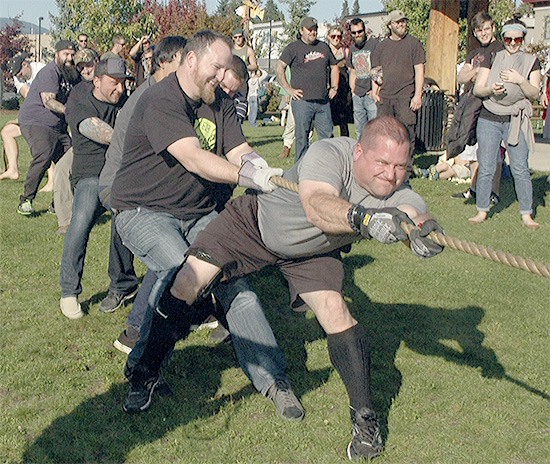ARLINGTON — While myths of vikings who wore horned helmets and behaved like barbarians might persist in the media, visitors to Arlington’s downtown Oct. 3 received some hands-on lessons about the real history of viking cultures, during the city and Down Arlington Business Association’s first “Viking Fest.”
Given the number of local residents descended from Swedes, Norwegians and Scandinavians, the Viking Fest offered a unique opportunity to learn about their heritage, as well as to explore the participating businesses of Olympic Avenue and beyond.
PaZazz! Hair Design stylists Anita O’Sullivan and Sarah Ashcraft gave attendees authentic viking hairdos.
“They wanted their hair out of their face for fighting,” Ashcraft said.
O’Sullivan added: “They couldn’t wash their hair every day, either, so the braids kept it neat.”
Debra Callaway and Shauna Olds demonstrated a warp-weighted loom, which uses hanging stones and donut-shaped pieces of pottery to keep threads taut. The model in Legion Park, which came up to chest height on the two women, is about a third of the size of the models that viking cultures used.
“You could put this loom up against a wall and weave bigger pieces on it,” Callaway said. “The standard stereotype of these people was that they were just plunderers, but they had home lives as well. Being vikings wasn’t who they were, but what they did. They had to explore.”
Olds added: “They were resource-limited. They had to either expand or die.”
Union sheet-metal worker Alan Stewart showed off a helmet he’d made in nine hours, and a metal mail shirt a friend of his has spent more than a week working on.
“Each link in the chain shirt is interlocked with four separate links,” said Stewart, who pointed out how each link is fastened with a tiny rivet that punctures the overlap of metal to hold it together, like a miniature handcuff. “It takes about five minutes to make a single rivet, and there’s at least a thousand rings in just one of the shirt’s sleeves. This would have been worth a fortune in the old days. Back then, steel was worth more than silver.”
Bill Gruner has spent his retirement years making viking armor and weapons. He pointed out that “chain mail” is redundant, “since you’re saying the same word twice,” and underscored Stewart’s remarks by noting that steel was relatively rare, due to how difficult it was to forge.
“Vikings preferred axes and spears to swords, because they were more versatile in their uses and didn’t take as much metal to make,” Gruner said, elaborating that axes could be thrown or used to cut wood. Even the vikings’ sword of choice, a single-edged blade called a “seax,” required less metalworking.
“It’s also more effected as a percussive weapon,” he added. “You’re going to know if I hit you with it.”
While mail shirts will withstand a number of blows, Gruner noted they would not stop an axe, which is where the vikings’ shields came in.
“You don’t hold it directly in front of your chest, because then you have nowhere left to push out,” Gruner said. “You also want to keep your own face away from the edge of the shield. You should set of the shield on your shoulder, so you can use its edge offensively.”
Gruner passed on these tips to participants in the “Shield Wall” mock-combat training later that day, showing them how to handle their wooden weapons safely in Legion Park.
“A lot of the vikings’ armor, including their shields and helmets, were Roman army surplus,” Gruner said, added that the two groups were trading wine as early as 500 B.C. “The helmets are very much late-period Roman, from when the empire was deteriorating and the helmets were simplified.”
Joel Smith and his wife, Loki, recreated the vikings’ woodworking and wool processing, respectively.
“These people spent a lot of their tie in the dark and cold, so their everyday objects were crafted to give them joy,” Smith said, pointing to the ornately carved details on handles of his wooden utensils. “At the same time, utility came first. These things were meant to be used, not hung on a wall.”
Loki showed off a barrel wool-carder that would have been far too pricey for the average citizen in the 1300s.
“Fur and leather were cheap by comparison to wool,” Loki said. “The long-fiber wool came off the spinner, while the short-fiber wool was turned into felt. When people complained, even as recently as thirty years ago, about wool being too itchy, it’s because it was stored in high temperatures [above 110 degrees], which brought out its micro-barbs like they were chitin, the material fingernails are made of.”
As locals, the Smiths were thrilled to see Arlington celebrating their heritage and interests, especially as they continue to recover from last year’s Oso slide.
While some of the day’s other activities, including its elimination-round tug-of-war and pizza-eating contests, placed more emphasis on entertainment than historic and cultural accuracy, Stewart appreciated having the outlet for what’s become a family pursuit.
“We teach our children about the viking lifestyle,” Stewart said. “I grew up a Boy Scout, so there’s a lot of the same emphasis on learning crafts and survival skills. These people were incredibly innovative, and we hope to emulate their self-sufficiency.”








